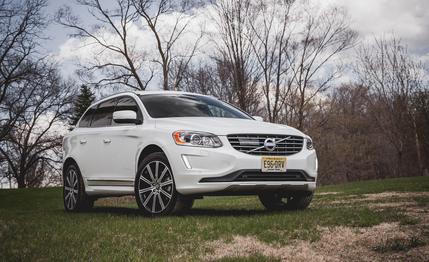 Instrumented Test
Instrumented Test
The XC60 crossover was Volvo’s second-bestselling model in 2013, and it’s an attractive compact hauler that acquits itself well among the entry-luxury competition. But it’s a tough arena, one dominated by several all-star players that include the Audi Q5, BMW X3, and Mercedes GLK, with the new Porsche Macan just entering the fray. The stats tell the story: Last year, XC60 sales (19,766) trailed the X3’s by 10,857 units, the GLK’s by 12,787, and the Q5’s by a discouraging 20,589.
Volvo’s response to this challenge is an updated 2015 powertrain lineup that now includes the firm’s new Drive-E engine family, which builds on a mild 2014 cosmetic freshening. The naturally aspirated 3.2-liter and turbocharged 3.0-liter inline-sixes continue to power all-wheel-drive models, but the new front-drive-exclusive, forced-induction four-cylinder engines are the big developments.
There are two levels of four-cylinder power, denoted by T5 and T6 badging. The T5 is turbocharged and rated for 240 horsepower and 258 lb-ft of torque. That’s respectable, but the T6 edition tested here has both turbo- and supercharging, and it huffs up 302 horses at 5700 rpm and 295 lb-ft from 2100 to 4500 rpm. The eight-speed automatic paired with the four-hole engines is also new. (Yes, the engine lineup and badging—you can also get a T6 six-cylinder—are confusing, but all will be sorted out once Volvo completes its conversion to a fully four-cylinder powertrain portfolio.)
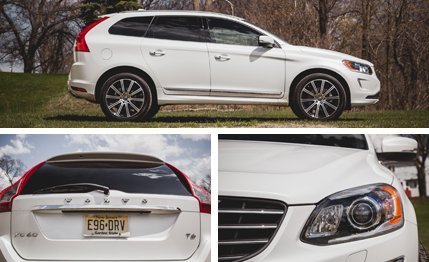
Yet another new element is Volvo’s ECO+ feature, dedicated to reducing fuel consumption by optimizing transmission shift points and throttle mapping. It also governs the stop-start function, which can silence the engine even when the XC60 is in motion as the vehicle coasts to a red light or stop sign.
Volvo claims ECO+ can improve fuel economy by as much as five percent. We can neither verify nor refute the claim, but we can say that its effect on street performance is essentially transparent. For a two-ton vehicle with 302 horsepower, the T6 achieved respectable ratings in the EPA test cycle: 22 mpg city, 30 mpg highway. But boost is habit forming and mileage zapping, so we underachieved once again, registering 20 mpg for this test.
Boost Me Once, Boost Me Twice
The supercharged and turbocharged T6 version of the new 2.0-liter is otherwise sweet, however. The supercharger builds boost at low engine speeds, mitigating the lag typical of turbochargers, and the two work in tandem for seamless response throughout the rev range. Our XC60 T6 hustled to 60 mph in 6.1 seconds and arrived at the quarter-mile mark in 14.6 seconds at 97 mph. Those sprints compare favorably with those of Volvo’s German rivals, thanks in part to a curb weight (4096 pounds in this front-drive model) that’s near the low end of the scale for this class.
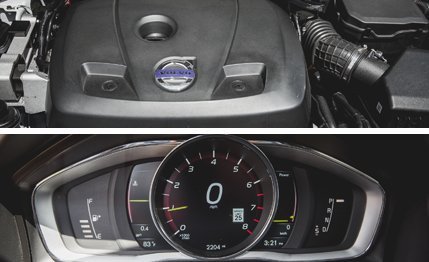
The Volvo’s behavior on public roads, be they freeways or winding country byways, also compares favorably to its luxe crossover peers. But if you’re used to a car, a crossover’s tallish profile and higher center of gravity inevitably translate as relative dynamic compromises, and the XC60 proves no exception to this rule.
Nevertheless, its combination of balanced suspension tuning and precise steering add up to quick responses. A meaty set of 255/45-20 Pirelli Scorpion Zero Asimmetricos delivered so-so grip on our skidpad, at 0.82 g. Our braking test results were also just fair, with 178 feet needed to stop from 70 mph. Compared with the Germans, though, the Volvo is in the thick of things in terms of grip, and only the Audi drops anchor better. Chassis rigidity is a strong suit of the XC60, and its ride quality is supple, despite firm spring rates and higher-than-average roll stiffness.
The new eight-speed transmission is smooth in full automatic operation, although there were a couple of odd lurches at parking-lot speeds, as though its electronic brain weren’t quite sure which gear to engage. Using the paddle shifters is reasonably satisfying, even though shifts aren’t quite as quick as those from some dual-clutch units. The tachometer display reads to 8000 rpm, but the transmission upshifts automatically at about 6300 rpm.
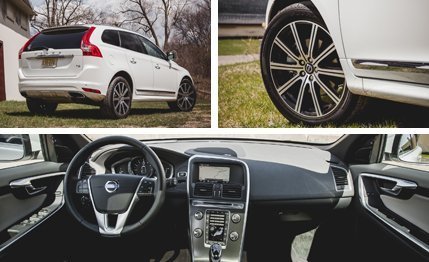
Even though the XC60 is a generally pleasant place to be for hauls both long and short, there are some traits that aren’t so endearing. For one, it’s quiet enough on smooth pavement, but the XC60 gets a little too loud inside on rough surfaces due to noise transmitted through the suspension. Our front-drive test unit exhibited hints of torque steer at low speeds with wide-open throttle. But we were most dissatisfied with the stop-start function. In seeking to prevent every combustion event that could even remotely be classified as unnecessary, it asserts itself too soon and too often. One could argue, though, that it’s merely trying to justify its presence.
Safe in the City
Volvo has long been a leader in safety features, and the XC60 maintains that tradition. Numerous competitors offer systems that will autonomously initiate braking at highways speeds if the computer decides the driver isn’t responding to the situation, but they’re often far too zealous and limited in their abilities. Volvo’s City Safety feature operates in heavy urban traffic and will completely stop the car from speeds up to 30 mph, and it’s very well programmed. There are now pedestrian- and bicycle-detection features baked into the system, which makes it even more impressive.
All the vehicles contending in this class have attractive, comfortable interiors, and the XC60 measures up well in that regard. The front seats—heated, cream-and-black leather-clad in our example—are heavenly, the sound system is first-rate, and there are plenty of connectivity options.
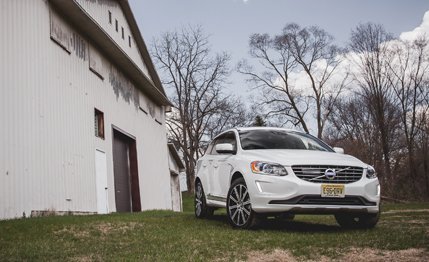
The XC60 lineup ranges from the base front-drive T5, which starts at $36,675, to the T6 AWD R-Design Platinum, which is priced from $50,725. With a base price just over $40,000, our front-drive T6 sits a little below the middle rung on the pricing ladder.
But, of course, there were additions. The $4000 Platinum package added navigation, premium audio, a rearview camera, a power liftgate, power-retractable side mirrors, and auto dimming for all mirrors, among other lesser features. The Sport package brought more heavily bolstered seats and 20-inch wheels, as well as $1500 to the bottom line. The Tech package also runs $1500 and included adaptive cruise control, collision warning with auto braking, pedestrian-and-cyclist detection, lane-departure warning, active high-beams, and distance alert. Rounding out the options were $800 active xenon headlights, and a $900 Blind Spot Information package (blind-spot warning, cross-traffic alert, lane-change merge aid, and front and rear park assist).
Metallic paint and heated seats brought the as-tested total to $50,725—a more sobering total, to be sure, but still competitive with the Teutonic establishment. The XC60 might not have a German name or pedigree, but it speaks the same language.